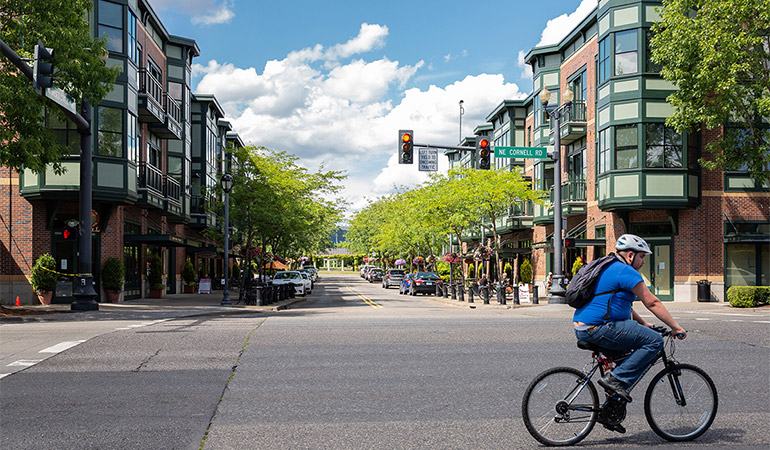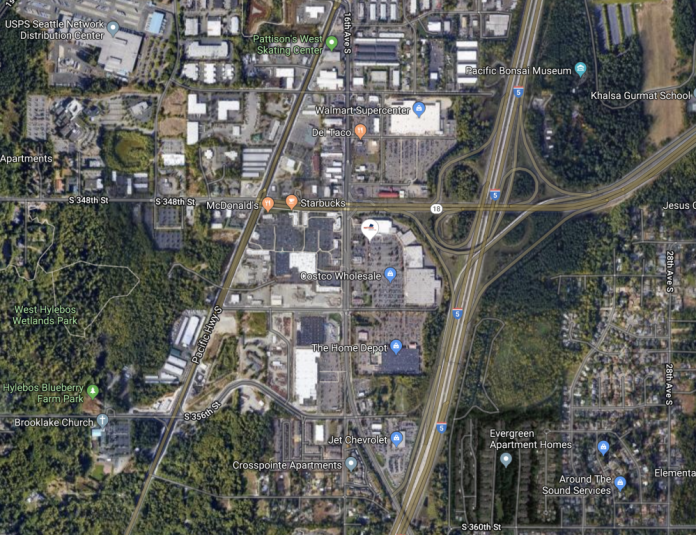Federal Way is working through the initial stages of a subarea planning process in the southern portion of the city. The “City South” area, which is just southwest of I-5/SR-18 interchange, is largely a big box retail and suburban strip commercial area. That could change in the years ahead, but Federal Way is taking a first step to this by seeking feedback on community priorities. This will information will be used to establish a general vision for the area, which could simply mean expanding the status quo land use or moving toward development of a mixed-use, transit-oriented district.
Through the Framing City South subarea planning process, planners will issue a summary report on what the community vision is and then determine how to proceed in realizing it. That could culminate in updated policies, zoning changes, and enhanced development regulations.

City South is hemmed in by I-5 on east and centered on Pacific Highway and Enchanted Parkway between S 344th St and S 359th St. Although a bit of hodgepodge of strip, the area is well known for anchor retailers like Costco, Home Depot, and Lowe’s Home Improvement. The area also has a variety of other commercial services, storage, fast-food restaurants, and a limited amount of housing (mostly apartments) that is situated on the south end.
The City South area is slated to get a Link light rail station in 2030. The preferred station location would be situated at Enchanted Parkway and S 352nd St. However, an alternative station location further south, next to I-5 between S 356th St and Enchanted Parkway, is also being considered. Unfortunately, the Washington State Department of Transportation (WSDOT) has a conflicting proposal to build another off-ramp from I-5 at S 356th St, which could be completed by 2027. This will have the regrettable and considerable impact of reinforcing and further inducing the auto-dominated nature of the area.

Planners want to know, however, what people hope to see in the future at City South. The visioning process is so far relatively open-ended, but to get people thinking about options, planners have suggested four broad approaches to consider: a suburban-style retail and commercial area, a mixed-use residential neighborhood, a compact mixed-use district, or an urban-style retail and commercial center. The characteristics of these four alternatives offered by planners are fairly distinct:
- A suburban-style retail and commercial area would essentially be the status quo with large, single-story buildings for big box retailers. Expansive parking lots would be the norm with buildings often set deeply back from the street. The area would functionally be auto-driven with little pedestrian, biking, and transit access.
- A mixed-use residential neighborhood would place an emphasis on townhouses and other residential uses with some ground floor retail. Buildings would tend to be up to three stories tall, closer to the street, and on much smaller blocks than today. Parking would still tend to be surface, but garages may be more common. A greater variety of street types (not just arterials and parking lot driveways) would be present, offering opportunities for landscaped sidewalks, bike lanes, on-street parking, lighting, and other complete streets features.
- A compact mixed-use district would be much broader in use with apartments, townhouses, retail, and other commercial uses, such as office. Buildings would typically be up to four or five stories, with mixed-use (three or four floors of residential over commercial uses) being common. Buildings would generally be oriented to streets on small block. Parking would usually be oriented away from the street. A greater variety of street types (not just arterials and parking lot driveways) would be present, offering opportunities for landscaped sidewalks, bike lanes, on-street parking, lighting, and other complete streets features.
- An urban-style retail and commercial center would naturally emphasize retail uses, but also accommodate other commercial activities like offices and hotels. Residential could form a small portion of uses allowed. Buildings would generally be five to seven stories tall, oriented close to the street, and on small- and medium-sized blocks. Parking would generally be structured below ground or behind buildings, or in a consolidated location. A greater variety of street types (not just arterials and parking lot driveways) would be present, offering opportunities for landscaped sidewalks, bike lanes, on-street parking, lighting, and other complete streets features. This, however, may not be as well connected as the two aforementioned options.
With this in mind, the public can provide feedback on the high-level priorities for City South and a particular development approach via Federal Way’s online open house; the online open house and survey are open through December 15th. Federal Way planners hope to provide another online open house this winter (likely January) to highlight themes and issues they heard and seek confirmation on a vision direction before finalizing a vision report for the subarea in the spring. At that point, the city will share information on the report and determine next steps.
Stephen is a professional urban planner in Puget Sound with a passion for sustainable, livable, and diverse cities. He is especially interested in how policies, regulations, and programs can promote positive outcomes for communities. With stints in great cities like Bellingham and Cork, Stephen currently lives in Seattle. He primarily covers land use and transportation issues and has been with The Urbanist since 2014.


